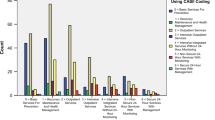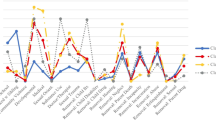Abstract
Among youth in child welfare ages 6–17 years, 40 % meet the criteria for one or more DSM diagnoses. For minority youth in child welfare, poor mental health is compounded by limited access to care and racial disparity bias, leading to poorer outcomes. This paper uses data collected and analyzed by an automated behavioral health assessment system for a multiyear study that focused on ways to improve case planning in child welfare. Youth, their caseworkers, and, in some cases, parents completed assessments that measured and monitored the youths’ needs and strengths. More than 60 % of youth participating in the study were African-American; permanency rates after six months of case planning were found to be only one third. Predictive factors related to better behavioral health and permanency outcomes are identified and discussed, as well as the implications for improving case planning by incorporating the views of multiple informants, including the youth.

Similar content being viewed by others
References
National Child Welfare Resource Center. Mental health issues in the child welfare system. Best Practice, Next Practice: Family-Centered Child Welfare Summer 2003; 1–30.
Wood, P.A., Yeh, M., Pan, D., et al. Exploring the relationship between race/ethnicity, age of first school-based services utilization, and age of first specialty mental health care for at-risk youth. Mental Health Services Review 2004; 7(3), 185–196.
Garland, A.F., Lau, A.S., Yeh, M., et al. Racial and ethnic differences in utilization of mental health services among high-risk youths. American Journal of Psychiatry 2005; 162(7), 1336–1343.
Kodjo, C.M., Auinger, P. Predictors for emotionally distressed adolescents to receive mental health care. Journal of Adolescent Health 2004; 35(5), 368–373.
Yeh, M., McCabe, K., Hough, R.L., et al. Racial/ethnic differences in parental endorsement of barriers to mental health services for youth. Mental Health Services Research 2003, 5(2), 65–77.
Courtney, M., Skyles, A. Racial disproportionality in the child welfare system. Children and Youth Services Review 2003; 25, 355–358.
Connell, C.M., Vanderploeg, J.J., Flaspohler, J.J., et al. Changes in placement among children in foster care: A longitudinal study of child and case influences. Social Service Review 2006; 80, 398–418.
James, S. Why do foster care placements disrupt? An investigation of reasons for placement change in foster care. Social Service Review 2004; 78, 601–627.
Newton, R.R., Litrownik, A.J., Landsverk, J.A. Children and youth in foster care: Disentangling the relationship between problem behaviors and number of placements. Child Abuse & Neglect 2000; 24, 1363–1374.
Leslie, L.K., Landsverk, J., Ezzet-Lofstrom, R., et al. Children in foster care: Factors influencing outpatient mental health service use. Child Abuse & Neglect 2000; 24, 465–476.
Leon, S.C., Uziel-Miller, N.D., Lyons, J.S., et al. Psychiatric hospital service utilization of children and adolescents in state custody. Journal of the American Academy of Child and Adolescent Psychiatry 1999; 38, 305–310.
McMillian, J.C., Scott, L.D., Zima, B.T., et al. Use of mental health services among older youths in foster care. Psychiatric Services 2004; 55, 811–817.
Lyons, J.S., Mintzer, L.L., Kisiel, C.L., et al. Understanding the mental health needs of children and adolescents in residential treatment. Professional Psychology: Research and Practice 1998; 29, 582–587.
Chang, D.F., Sue, S. The effects of race and problem type on teachers’ assessments of student behavior. Journal of Consulting and Clinical Psychology 2000; 36(5), 610–619.
Crane, K.D., Ellis, R.A. Benevolent intervention or oppression perpetuated: Minority overrepresentation in children’s services. Journal of Human Behavior in the Social Environment 2004; 9,(1-2), 19–38.
Cullinan, D., Kauffman, J.M. Do race of student and race of teacher influence ratings of emotional and behavioral problem characteristics of students with emotional disturbances? Behavioral Disorders 2005; 30(4), 393–402.
Kataoka, S.H., Zhang, L., Wells, K.B. Unmet need for mental health care among U.S. children: Variation by ethnicity and insurance status. American Journal of Psychiatry 2002; 159(9), 1548–1555.
Burns, B.J., Costello, E.J., Angold, A., et al. Children’s mental health service use across service sectors. Health Affairs 1995; 14(3), 147–159.
McCarthy, J., Marshall, A., Irvine, M., et al. An analysis of mental health issues in states’ child and family service reviews and program improvement plans. Georgetown University: National Technical Assistance Center for Children’s Mental Health, 2004.
Fromm, S. Total estimated cost of child abuse and neglect in the United States: Statistical evidence. Technical report, Edna McConnell Clark Foundation, Chicago: Illinois. pp 2–3, 2001.
Wang, C.T., Holton, J. Total estimated cost of child abuse and neglect in the United States, 2007. Accessed at www.preventchildabuse.org/about_us/media_releases/pcaa_pew_economic_impact_study_final.pdf.
Johnson, J.G., Cohen, P., Brown, J., et al. Childhood maltreatment increases risk for personality disorders during early childhood. Archives of General Psychiatry 1999; 56, 600–606.
Kessler, R.C., Davis, C.G., & Kendler, K.S. Childhood adversity and adult psychiatric disorder in the US National Comorbidity Survey. Psychological Medicine 1997; 27, 1101–1119.
Milan, S.E., & Pinderhughes, E.E. Factors influencing maltreated children’s early adjustment in foster care. Development and Psychopathology 2000; 12, 63–81.
Shields, A., Ryan, R. M., & Cicchetti, D. Narrative representations of caregivers and emotional dysregulation as predictors of maltreated children’s rejection by peers. Developmental Psychology 2001; 37, 321–337.
Thomas, P.M. Protection, dissociation, and internal roles: Modeling and treating the effects of child abuse. Review of General Psychology 2003; 7(4), 364–380.
Toche-Manley, L.L., Nankin, M., Dietzen, L. Using outcome data to create clinical change: Foundations and example. Child & Youth Forum 2004; 33(1), 51–67.
Lyons, J.S. The severity and acuity of psychiatric illness. Child and Adolescent Version. San Antonio TX: The Psychological Corporation, 1998.
Lyons, J.S., Kisiel, C.L., Dulcan, M., et al. Crisis assessment and psychiatric hospitalization of children and adolescents in state custody. Journal of Child & Family Studies 1997; 6, 311–320.
Bickman, L., Guthrie, P.R., Foster, E.M., et al. Evaluating Managed Mental Health Services: The Fort Bragg Experiment. New York: Plenum, 1995.
Tangney, J.P. Recent advances in the empirical study of shame and guilt. American Behavioral Scientist 1995; 38(8): 1132–1145.
Rogosch, F.A., Cicchetti, D., & Aber, J.L. The role of child maltreatment in early deviations in cognitive and affective processing abilities and later peer relationship problems. Development and Psychopathology 1995; 7, 591–609.
Augustyn, M., D. A. Frank, et al. (2002). Children who witness violence, and parent report of children's behavior. Archives of Pediatrics and Adolescent Medicine 156(8): 800–803.
Hanley, J. A. & McNeil, B. J. A method of comparing the areas under receiver operating characteristic curves derived from the same cases. Radiology, 1983;148(3), 839–843.
Hanley, J. A. & McNeil, B. J. The meaning and use of the area under a receiver operating characteristic (ROC) curve. Radiology, 1982;143, 29–36.
Sanchez, R.M. Youth Perspectives on Permanency. San Francisco, CA: California Permanency Project for Youth, 2004.
Grissom, G. The Advent of Outcomes Management and the Culture of Measurement. In Behavioral Outcomes and Guidelines Sourcebook. New York: Faulkner and Gray, 2000.
Author information
Authors and Affiliations
Corresponding author
Rights and permissions
About this article
Cite this article
Toche-Manley, L.L., Dietzen, L., Nankin, J. et al. Are Two Voices Better Than One? Predicting Permanency in Minority Youth Using Multi-informant Mental Health and Strength Data. J Behav Health Serv Res 41, 356–369 (2014). https://doi.org/10.1007/s11414-012-9280-4
Published:
Issue Date:
DOI: https://doi.org/10.1007/s11414-012-9280-4




